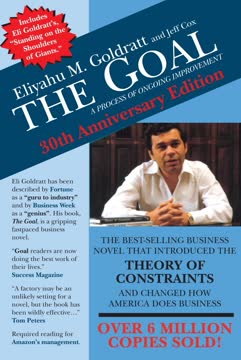نکات کلیدی
1. صورتهای مالی زبان تجارت هستند
قوانین حسابداری مکانیزمی را فراهم میکنند که از طریق آن معاملات تجاری و رویدادهای اقتصادی به اعداد تبدیل میشوند.
تسلط مالی ضروری است. درک صورتهای مالی برای مدیران در تمام سطوح حیاتی است. این اسناد راهی استاندارد برای ارتباط وضعیت مالی و عملکرد یک شرکت ارائه میدهند. آنها شامل سه بخش اصلی هستند: ترازنامه، صورت سود و زیان، و صورت جریان نقدی. هر یک دیدگاه منحصربهفردی از وضعیت مالی شرکت ارائه میدهد.
تفسیر اعداد کلیدی است. صورتهای مالی فقط درباره اعداد نیستند؛ آنها داستانی را روایت میکنند. مدیران باید یاد بگیرند که چگونه بین خطوط را بخوانند، فرضیات پشت ارقام را درک کنند و مناطق بالقوه دستکاری یا تحریف را شناسایی کنند. این مهارت به آنها اجازه میدهد تصمیمات آگاهانهتری بگیرند و به بحثهای استراتژیک بهطور معناداری کمک کنند.
یادگیری مداوم ضروری است. حوزه حسابداری و مالی بهطور مداوم در حال تکامل است و مقررات و بهترین شیوههای جدید بهطور منظم ظهور میکنند. مدیران باید به آموزش مداوم متعهد شوند تا بهروز بمانند و سواد مالی خود را حفظ کنند. این میتواند شامل خواندن اخبار مالی، شرکت در کارگاهها یا جستجوی راهنمایی از متخصصان مالی در سازمانشان باشد.
2. ترازنامهها وضعیت مالی شرکت را نشان میدهند
داراییها = بدهیها + حقوق صاحبان سهام
نمایی از سلامت مالی. ترازنامه دیدگاهی در لحظه از وضعیت مالی یک شرکت ارائه میدهد. نشان میدهد که شرکت چه چیزی دارد (داراییها)، چه چیزی بدهکار است (بدهیها)، و ارزش باقیماندهای که به سهامداران تعلق دارد (حقوق صاحبان سهام). این معادله بنیادی همیشه باید در تعادل باشد و ماهیت دوگانه هر معامله مالی را منعکس کند.
ترکیب داراییها مهم است. انواع و نسبتهای داراییهایی که یک شرکت دارد میتواند اطلاعات زیادی درباره مدل کسبوکار و استراتژی آن ارائه دهد. دستههای کلیدی شامل:
- داراییهای جاری (مانند وجه نقد، موجودی کالا، حسابهای دریافتنی)
- داراییهای غیرجاری (مانند املاک، کارخانه، تجهیزات، داراییهای نامشهود)
ساختار تأمین مالی بر ریسک تأثیر میگذارد. بخش بدهیها و حقوق صاحبان سهام در ترازنامه نشان میدهد که شرکت چگونه داراییهای خود را تأمین مالی کرده است. این شامل:
- بدهیهای کوتاهمدت (مانند حسابهای پرداختنی، بدهی کوتاهمدت)
- بدهیهای بلندمدت (مانند بدهی بلندمدت، تعهدات بازنشستگی)
- حقوق صاحبان سهام (مانند سود انباشته، سرمایه پرداختشده)
نسبت بدهی به حقوق صاحبان سهام، که به عنوان اهرم شناخته میشود، شاخصی حیاتی از ریسک مالی و انعطافپذیری است.
3. صورتهای سود و زیان سودآوری و عملکرد را اندازهگیری میکنند
درآمد و رشد مهم هستند، اما همه داستان نیستند.
فراتر از خط پایانی. در حالی که سود خالص اغلب به عنوان "خط پایانی" نامیده میشود، تمرکز صرف بر این رقم میتواند گمراهکننده باشد. صورت سود و زیان تجزیه و تحلیل دقیقی از چگونگی تولید درآمد و تحمل هزینهها توسط یک شرکت در یک دوره خاص ارائه میدهد. این به مدیران اجازه میدهد جنبههای مختلف عملکرد مالی را تحلیل کنند.
شاخصهای کلیدی عملکرد. معیارهای مهمی که از صورت سود و زیان به دست میآیند شامل:
- حاشیه سود ناخالص: (درآمد - هزینه کالاهای فروختهشده) / درآمد
- حاشیه عملیاتی: درآمد عملیاتی / درآمد
- حاشیه سود خالص: سود خالص / درآمد
این نسبتها به ارزیابی کارایی و سودآوری در مراحل مختلف عملیات کمک میکنند.
تحلیل روند حیاتی است. مقایسه صورتهای سود و زیان در دورههای مختلف میتواند روندهای مهمی در رشد درآمد، مدیریت هزینه و سودآوری کلی را آشکار کند. این اطلاعات برای برنامهریزی استراتژیک و شناسایی مناطق برای بهبود یا سرمایهگذاری حیاتی است.
4. صورتهای جریان نقدی نقدینگی و مدیریت نقدی را پیگیری میکنند
تمام شدن نقدینگی به وضوح ایده خوبی نیست!
نقدینگی پادشاه است. در حالی که سودآوری مهم است، توانایی یک شرکت در تولید و مدیریت نقدینگی برای بقا و رشد حیاتی است. صورت جریان نقدی تغییر در تراز نقدی را در یک دوره آشتی میدهد و جریانهای نقدی را به سه فعالیت اصلی دستهبندی میکند:
- فعالیتهای عملیاتی
- فعالیتهای سرمایهگذاری
- فعالیتهای تأمین مالی
کارایی عملیاتی. جریان نقدی از عملیات شاخصی کلیدی از توانایی یک شرکت در تولید نقدینگی از فعالیتهای اصلی کسبوکار خود است. جریان نقدی عملیاتی مثبت بهطور مداوم عموماً نشانه خوبی است، در حالی که جریان نقدی منفی ممکن است نشاندهنده مشکلاتی در سودآوری یا مدیریت سرمایه در گردش باشد.
تصمیمات سرمایهگذاری و تأمین مالی. بخشهای سرمایهگذاری و تأمین مالی بینشی درباره چگونگی استفاده یک شرکت از سرمایه برای رشد و چگونگی تأمین مالی آن سرمایهگذاریها ارائه میدهند. این اطلاعات برای درک استراتژی بلندمدت و سلامت مالی یک شرکت حیاتی است.
5. حاشیههای سود و نسبتهای بازده کارایی عملیاتی را ارزیابی میکنند
ROA = حاشیه سود x گردش دارایی
سودآوری در زمینه. حاشیههای سود بهتنهایی داستان کامل عملکرد یک شرکت را نمیگویند. بازده داراییها (ROA) و بازده حقوق صاحبان سهام (ROE) با در نظر گرفتن منابع استفادهشده برای تولید آن سودها دیدگاه جامعتری ارائه میدهند.
اجزای عملکرد. ROA را میتوان به دو جزء کلیدی تقسیم کرد:
- حاشیه سود: اندازهگیری میکند که چقدر سود از هر دلار فروش تولید میشود
- گردش دارایی: نشان میدهد که داراییها چقدر کارآمد برای تولید فروش استفاده میشوند
این تجزیه و تحلیل به مدیران اجازه میدهد تا شناسایی کنند که بهبودهای سودآوری از مدیریت بهتر قیمت/هزینه یا استفاده کارآمدتر از داراییها ناشی میشود.
ساختار سرمایه تأثیر میگذارد. ROE بر اساس ROA با در نظر گرفتن اثرات اهرم (تأمین مالی بدهی) ساخته میشود. در حالی که اهرم بالاتر میتواند بازده را در زمانهای خوب تقویت کند، همچنین ریسک مالی را افزایش میدهد. مدیران باید تعادل بین پتانسیل بازده بالاتر و آسیبپذیری بیشتر در برابر رکود اقتصادی را برقرار کنند.
6. تحلیل رفتار هزینهها تصمیمگیری استراتژیک را اطلاعرسانی میکند
هزینههای ثابت آنهایی هستند که با تغییر سطح فعالیت، مانند حجم فروش، تغییر نمیکنند.
درک ساختارهای هزینه. هزینهها را میتوان به عنوان ثابت یا متغیر دستهبندی کرد و این تمایز برای تصمیمگیری حیاتی است. هزینههای ثابت بدون توجه به حجم تولید ثابت میمانند، در حالی که هزینههای متغیر به نسبت خروجی تغییر میکنند. این دانش برای:
- تحلیل نقطه سر به سر
- تصمیمات قیمتگذاری
- برنامهریزی تولید
مفهوم حاشیه مشارکت. حاشیه مشارکت (قیمت منهای هزینههای متغیر) نشان میدهد که هر واحد فروش چقدر به پوشش هزینههای ثابت و تولید سود کمک میکند. این معیار برای:
- ارزیابی سودآوری محصول
- تصمیمگیری درباره سفارشات ویژه یا تخفیفها
- بهینهسازی ترکیب محصول
محدودیتهای منابع مهم هستند. هنگامی که منابع (مانند ظرفیت تولید، نیروی کار ماهر) محدود هستند، مدیران باید حاشیه مشارکت به ازای هر واحد از منبع محدود را در نظر بگیرند. این اطمینان میدهد که منابع کمیاب به سودآورترین محصولات یا فعالیتها اختصاص داده میشوند.
7. تحلیل جریان نقدی تنزیلشده سرمایهگذاریهای بلندمدت را ارزیابی میکند
ارزش فعلی جریان نقدی پروژه ارزش اقتصادی افزوده یا کاهشیافته توسط آن پروژه را اندازهگیری میکند.
ارزش زمانی پول. اصل اصلی تحلیل جریان نقدی تنزیلشده (DCF) این است که پولی که در آینده دریافت میشود کمتر از همان مقدار پولی که امروز دریافت میشود ارزش دارد. این مفهوم برای ارزیابی سرمایهگذاریهایی با جریانهای نقدی که در دورههای طولانی رخ میدهند حیاتی است.
اجزای کلیدی تحلیل DCF:
- جریانهای نقدی پیشبینیشده: برآورد جریانهای ورودی و خروجی آینده
- نرخ تنزیل: منعکسکننده ریسک جریانهای نقدی و هزینه فرصت سرمایه
- ارزش نهایی: حساب کردن برای جریانهای نقدی فراتر از دوره پیشبینی
معیارهای تصمیمگیری. ارزش فعلی خالص (NPV) یک پروژه مجموع جریانهای نقدی تنزیلشده آن است. پروژههایی با NPV مثبت به شرکت ارزش میافزایند و باید دنبال شوند، در حالی که آنهایی با NPV منفی ارزش را از بین میبرند. نرخ بازده داخلی (IRR) نیز یک معیار مفید است که نرخ تنزیلی را نشان میدهد که در آن NPV برابر با صفر است.
8. سواد مالی مدیران را قادر میسازد تا ارزشآفرینی را هدایت کنند
صورتهای مالی منابع مهم اطلاعاتی هستند هم در نگاه به جلو برای سرمایهگذاری و هم در نگاه به گذشته برای ارزیابی عملکرد؛ مدیرانی که در حسابداری و مالی مهارت دارند در هر مرحله از چرخه مداوم "سرمایهگذاری، ارزیابی و بازنگری" مزیت دارند.
تصمیمگیری استراتژیک. سواد مالی به مدیران امکان میدهد تا:
- فرصتهای سرمایهگذاری را ارزیابی کنند
- عملکرد عملیاتی را ارزیابی کنند
- بهطور معناداری به بحثهای استراتژیک کمک کنند
- بهطور مؤثر با متخصصان مالی و مدیران اجرایی ارتباط برقرار کنند
چرخه بهبود مستمر. درک صورتهای مالی و تکنیکهای تحلیل به مدیران اجازه میدهد تا:
- اهداف عملکرد معناداری تعیین کنند
- پیشرفت در برابر آن اهداف را نظارت کنند
- مناطق برای بهبود را شناسایی کنند
- استراتژیهایی برای افزایش ارزشآفرینی توسعه و ارزیابی کنند
دیدگاه گستردهتر. سواد مالی به مدیران کمک میکند تا فراتر از حوزه مسئولیت فوری خود را ببینند و درک کنند که تصمیمات آنها چگونه بر سلامت مالی کلی سازمان تأثیر میگذارد. این دیدگاه جامع ترویج همراستایی بهتر بین اهداف دپارتمانی و اهداف کلی شرکت را ترویج میکند.
آخرین بهروزرسانی::
FAQ
What’s "Financial Literacy for Managers" by Richard A. Lambert about?
- Demystifying financial statements: The book explains how to read, interpret, and use financial statements—balance sheets, income statements, and cash flow statements—for better business decision-making.
- Manager-focused financial skills: It’s designed for managers and executives without a finance or accounting background, focusing on practical application rather than technical accounting rules.
- Strategic decision support: Lambert shows how financial literacy empowers managers to evaluate strategies, assess performance, and make informed investment decisions.
- Real-world examples: The book uses case studies from companies like PepsiCo, Krispy Kreme, and General Motors to illustrate key concepts.
Why should I read "Financial Literacy for Managers" by Richard A. Lambert?
- Essential business skill: Understanding finance and accounting is critical for managers to make informed decisions and contribute to strategic discussions.
- Bridges knowledge gaps: The book is tailored for non-financial managers, helping them overcome confusion or intimidation around financial data.
- Improves decision quality: By learning to interpret financial statements, managers can identify performance drivers, spot risks, and avoid costly mistakes.
- Enhances career value: Mastering these concepts makes managers more valuable to their organizations and better equipped for leadership roles.
What are the key takeaways of "Financial Literacy for Managers" by Richard A. Lambert?
- Financial statements are interconnected: Balance sheets, income statements, and cash flow statements each provide unique insights but must be understood together.
- Accounting is subjective: Financial statements involve estimates, judgments, and sometimes ambiguity, so managers must read between the lines.
- Profitability vs. liquidity: Net income and cash flow are not the same; both must be analyzed to assess a company’s health.
- Strategic use of financial data: Financial literacy enables managers to evaluate investments, allocate resources, and develop coherent business strategies.
How does Richard A. Lambert define and explain the three fundamental financial statements?
- Balance Sheet: Shows a snapshot of a company’s assets, liabilities, and owners’ equity at a specific point in time, revealing capital structure and risk.
- Income Statement: Measures revenues, expenses, and profitability over a period, helping managers understand how profits are generated.
- Cash Flow Statement: Tracks cash inflows and outflows, categorized into operating, investing, and financing activities, highlighting liquidity and funding sources.
- Interconnectedness: The book details how these statements relate, with changes in one often affecting the others.
What are the most important financial concepts and terms explained in "Financial Literacy for Managers"?
- Key terms demystified: Concepts like GAAP, NPV, ROA, EBITDA, WACC, leverage, and more are clearly defined and contextualized.
- Accounting vs. economic reality: The book explains differences between income and cash, depreciation and asset value, and why liabilities can be positive.
- Subjectivity and estimates: Lambert discusses how financial statements rely on estimates (e.g., asset valuation, revenue recognition) and why skepticism is necessary.
- Cost classifications: The book covers fixed vs. variable costs, direct vs. allocated costs, and the importance of understanding cost behavior.
How does "Financial Literacy for Managers" by Richard A. Lambert help managers use financial statements for better decision-making?
- Performance analysis: Managers learn to dissect financial statements to identify strengths, weaknesses, and areas needing attention.
- Strategic resource allocation: The book teaches how to decide which activities to expand, cut, or outsource based on financial data.
- Forecasting and planning: Understanding financials helps managers predict the impact of decisions on costs, revenues, and profitability.
- Benchmarking: The book emphasizes comparing performance over time, against budgets, and with competitors to guide strategy.
What is the difference between profitability and liquidity according to "Financial Literacy for Managers"?
- Profitability (Net Income): Reflects the value generated over a period, including non-cash items and future expectations.
- Liquidity (Cash Flow): Focuses on actual cash generated and used, critical for meeting obligations and funding operations.
- Distinct but related: The book explains why a company can be profitable but run out of cash, or have strong cash flow but weak profits.
- Managerial implications: Both measures are essential for assessing financial health and making sound business decisions.
How does Richard A. Lambert explain Return on Assets (ROA), Return on Equity (ROE), and leverage?
- ROA: Measures how effectively a company uses its assets to generate profits, independent of financing structure.
- ROE: Assesses the return generated for shareholders, factoring in the effects of debt (leverage).
- Leverage: Using debt can amplify returns (or losses) for equity holders; the book explains when and why leverage increases risk.
- Strategic use: Managers learn to balance asset efficiency, profit margins, and capital structure to optimize performance.
What practical advice does "Financial Literacy for Managers" offer for analyzing costs and making decisions?
- Cost behavior analysis: Distinguish between fixed and variable costs to predict how profits change with sales volume.
- Contribution margin and break-even: Use these tools to assess profitability, set prices, and evaluate special orders.
- Avoiding common pitfalls: The book warns against relying on unitized fixed costs, misallocating overhead, and considering sunk costs in decisions.
- Resource constraints: Managers are taught to allocate limited resources to maximize contribution margins per constraint.
How does "Financial Literacy for Managers" by Richard A. Lambert teach managers to evaluate investment opportunities?
- Discounted cash flow (DCF): The book provides a framework for calculating present value and internal rate of return (IRR) for investment decisions.
- Time value of money: Emphasizes why future cash flows must be discounted to compare alternatives accurately.
- Incorporating risk and inflation: Managers learn to adjust cash flow projections and discount rates for risk and changing prices.
- Sensitivity analysis: The book advocates testing assumptions under different scenarios to avoid over-optimism and improve decision quality.
What are the most common accounting and measurement issues highlighted in "Financial Literacy for Managers"?
- Asset valuation: Differences between historical cost and fair value, and the impact on reported performance.
- Revenue recognition: Timing and judgment in recognizing sales, especially with credit sales and bundled products.
- Expense allocation: How methods like FIFO, LIFO, and immediate expensing of R&D can distort profitability.
- Off-balance-sheet items: The book discusses how companies may hide liabilities and why managers must look beyond the numbers.
What are the best quotes from "Financial Literacy for Managers" by Richard A. Lambert and what do they mean?
- "Accounting is more like a language." — Emphasizes that understanding financial statements is about interpreting meaning, not just numbers.
- "Profitability (value generated) and liquidity (cash generated) are not the same thing." — Highlights the need to analyze both net income and cash flow for a complete financial picture.
- "Sunk costs are often not treated as irrelevant by the person who sunk them!" — Warns against letting past investments cloud current decision-making.
- "The numbers that come out are no more accurate than the quality of the assumptions that went into the analysis." — Stresses the importance of realistic forecasting and skepticism in financial planning.
- "It’s the synergies that arise from merging managerial experience with finance and accounting skills that can generate the most value to you and to your organization." — Underscores the book’s central message: financial literacy amplifies managerial effectiveness.
نقد و بررسی
کتاب سواد مالی برای مدیران نقدهای متفاوتی دریافت کرده است و بهطور میانگین امتیاز 3.57 از 5 را کسب کرده است. برخی از خوانندگان آن را آموزنده و مختصر میدانند و از دسترسیپذیری آن برای تازهکاران مالی تمجید میکنند. در مقابل، برخی دیگر آن را به دلیل کمبود عمق یا بینشهای جدید برای افرادی که دانش پایهای از کسبوکار دارند، مورد انتقاد قرار میدهند. این کتاب به بررسی صورتهای مالی و محاسبات میپردازد و چندین خواننده اشاره کردهاند که مطالعهی سریعی دارد. برخی پیشنهاد میکنند که برای خواندن فیزیکی مناسبتر از نسخهی صوتی است. بهطور کلی، نظرات در مورد مفید بودن آن متفاوت است؛ برخی آن را خشک اما آموزنده میدانند، در حالی که دیگران از سادگی و ارزش آموزشی آن قدردانی میکنند.
Similar Books














